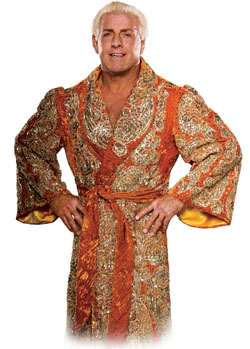 Yesterday I saw the biography disc on the DVD collection of Ric Flair’s greatest matches. Ric Flair (depicted on the left) was one of, if not the, greatest professional wrestlers that has ever stepped on to the matt. Were there a Moun Wrestlemore, his face would be a shoe in, and his long blond locks would be a point of despair for any team of stone carvers. But I digress. Ric Flair’s bio was filled with footage from his old matches, photos of him as a young man, and interviews with people he met along his journey to the top.
Yesterday I saw the biography disc on the DVD collection of Ric Flair’s greatest matches. Ric Flair (depicted on the left) was one of, if not the, greatest professional wrestlers that has ever stepped on to the matt. Were there a Moun Wrestlemore, his face would be a shoe in, and his long blond locks would be a point of despair for any team of stone carvers. But I digress. Ric Flair’s bio was filled with footage from his old matches, photos of him as a young man, and interviews with people he met along his journey to the top.
When asked what they remembered about Ric, almost every single fellow wrestler responded, “He made everyone he fought look like they could be a champion.” I can’t think of a better compliment for wrestling, or improv, or life for that matter. There were plenty of “He was talented,” “He was entertaining,” but what brought a tear to these mammoth-men’s eyes, was remembering what Ric did to make others look good.
Ric started his career before the WWE had taken over the wrestling business (and my fourth grade classroom). At that time, wrestling was mostly a local event. Regional champs would have a big following at home, and be unknown anywhere else. A loose alliance of promoters would pick one “World Champion” to travel around and fight all the local guys. After a lot of hard work, Ric got to be that guy.
So every night, and twice on weekends, he’d step into the ring with some hometown chump and his job was to make that guy look like he had a chance to beat the World Champ. The closer the match, the more exciting for the fans.
Most people are aware that wrestling is “fake”, but the way that it’s faked is almost harder than doing it for real. They don’t have time to choreograph matches with a 300 day/year touring schedule, so the wrestlers plan out a couple of big moments and improvise the rest in the ring. They train for hours on specific moves and techniques to make it look like they’re hurting people, while actually keeping them safe enough to fight the next day. In the ring the two wrestlers decide what to do to make the match worth watching, and then they end with the programmed finish. There’s not enough time to discuss what moves will work best when you’re stuck in a grapple with your partner, so all you can do is say “Yes” to the first choice.
Ric Flair was a master at this. He knew exactly what to do to make his fellow wrestler look like he was amazing, which moves to throw in when, and how to escalate the match to its conclusion. The audience would be on the edge of their seat, because they had no idea what would happen next, even though they knew it was fake.
All of those same skills are needed for good improv. The ability to make your scene partner look good, to make scenes fresh every night, to keep the show unpredictable, to keep the audience engaged even though they know it’s made up.
There are a lot of lessons in wrestling. They must be doing something ight, considering they are improvising new matches 300 nights/year for 20,000 – 60,000 screaming fans. I’m happy to see 20 – 60 people at a show, and no one’s ever made a sign for me. And Flair was known for his frequent 60 minute matches. I’d have to train like a wrestler just to able to handle that every night on stage.